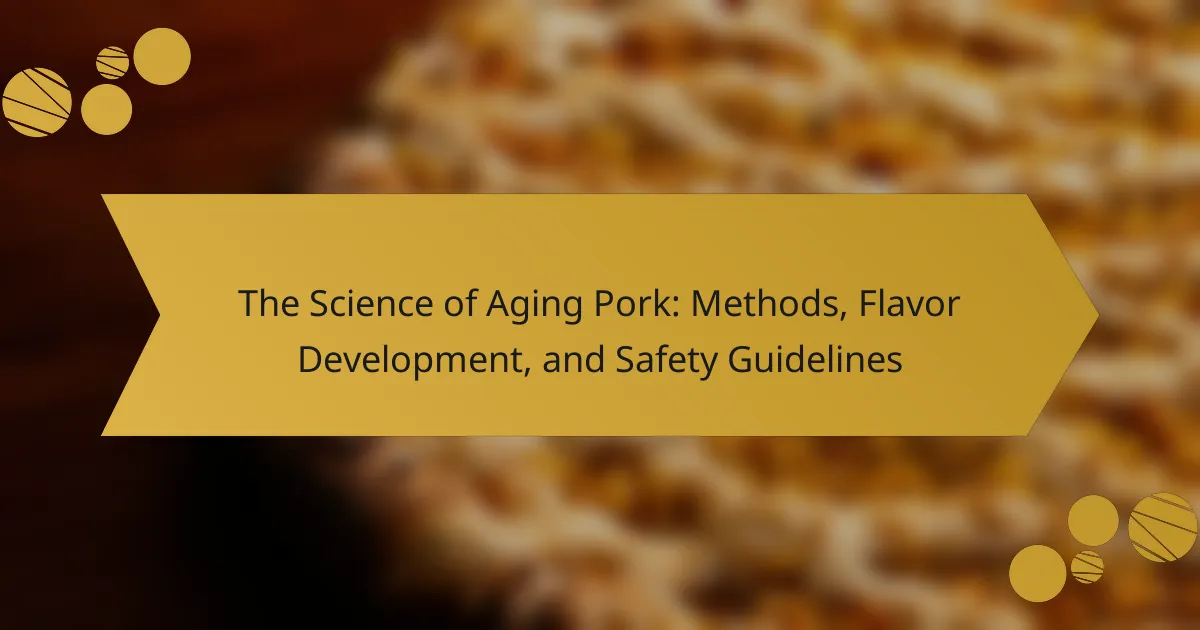
What is the science of aging pork?
Aging pork is a process that enhances its flavor and tenderness. It involves controlled storage of pork at specific temperatures and humidity levels. During aging, enzymes break down muscle proteins. This results in improved texture and taste. There are two primary methods: dry aging and wet aging. Dry aging occurs in a controlled environment, allowing moisture loss and flavor concentration. Wet aging involves vacuum-sealing pork in its juices, retaining moisture. Studies show that dry-aged pork can develop a richer flavor profile. Aging times can range from a few days to several weeks. Proper aging is essential for safety and quality.
How does aging pork influence its flavor and texture?
Aging pork enhances its flavor and texture significantly. The process of aging allows enzymes to break down muscle fibers. This results in a more tender texture. Additionally, aging develops complex flavors through the concentration of amino acids and fats. Dry aging promotes moisture loss, intensifying the meat’s taste. Studies show that dry-aged pork has a richer, nuttier flavor compared to fresh pork. The duration of aging also impacts these characteristics; longer aging times generally yield better tenderness and flavor.
What chemical processes occur during the aging of pork?
During the aging of pork, several chemical processes occur, primarily proteolysis and lipolysis. Proteolysis involves the breakdown of proteins into peptides and amino acids. This process is facilitated by enzymes such as calpains and cathepsins, which are activated during aging. Lipolysis refers to the breakdown of fats into free fatty acids and glycerol. This process enhances flavor by producing compounds that contribute to the meat’s taste and aroma. Additionally, the Maillard reaction may occur, resulting in browning and complex flavor development. These chemical changes improve the tenderness and overall quality of the pork.
How do different aging methods affect the final product?
Different aging methods significantly influence the final product’s flavor, texture, and tenderness. Dry aging enhances flavor through moisture loss and enzymatic activity, resulting in a concentrated taste. This method typically takes place over weeks in a controlled environment. Wet aging, on the other hand, retains moisture and focuses on tenderness rather than flavor development. It occurs in vacuum-sealed packaging for days to weeks. Research indicates that dry-aged pork can have a more robust flavor profile, while wet-aged pork is often more tender due to retained juices. The choice of aging method ultimately affects consumer preference and culinary applications.
Why is aging pork important in culinary practices?
Aging pork is important in culinary practices because it enhances flavor and tenderness. The process allows enzymes to break down muscle fibers, resulting in a more tender texture. Aging also intensifies the meat’s flavor profile, making it richer and more complex. Studies show that dry-aging pork can improve its taste significantly, with some chefs preferring it for gourmet dishes. This technique can also contribute to a more appealing color and aroma. Overall, aging pork is a key practice for achieving high-quality culinary results.
What are the taste benefits of aging pork?
Aging pork enhances its flavor and tenderness. The process allows enzymes to break down muscle fibers, resulting in a more tender texture. Additionally, aging intensifies the meat’s natural flavors. This occurs as moisture evaporates, concentrating the taste. The Maillard reaction develops complex flavor compounds during aging. Studies show that dry-aged pork has a richer, nuttier flavor profile compared to fresh pork. Aging also reduces the meat’s gamey taste, making it more palatable. Overall, aging pork significantly improves its culinary qualities.
How does aging pork enhance tenderness?
Aging pork enhances tenderness through a process called enzymatic breakdown. During aging, natural enzymes in the meat break down muscle fibers and connective tissues. This results in a softer texture. The aging process typically occurs in a controlled environment with specific temperature and humidity levels. Studies show that aging pork for at least 7 to 14 days significantly improves tenderness. Research indicates that dry aging can increase tenderness even further compared to wet aging. The breakdown of proteins contributes to this enhanced tenderness. Overall, aging pork is a scientifically supported method to improve its texture and eating quality.

What methods are used for aging pork?
The primary methods used for aging pork are dry aging and wet aging. Dry aging involves hanging the pork in a controlled environment with low humidity and cool temperatures. This method enhances flavor and tenderness over time. Wet aging, on the other hand, involves vacuum-sealing pork in plastic bags. It allows the meat to age in its own juices. Both methods can improve the overall quality of the pork. Dry aging can take several weeks, while wet aging typically lasts a few days to weeks. Studies show that dry-aged pork can have a more intense flavor compared to wet-aged pork.
What are the main types of pork aging methods?
The main types of pork aging methods are dry aging and wet aging. Dry aging involves hanging pork in a controlled, chilled environment for several weeks. This method enhances flavor and tenderness through moisture evaporation and enzymatic processes. Wet aging occurs when pork is vacuum-sealed and refrigerated for a shorter period. This method retains moisture and can also improve tenderness, but may not develop the same depth of flavor as dry aging. Both methods are utilized in the meat industry to enhance the quality of pork before it reaches consumers.
How does dry aging differ from wet aging?
Dry aging and wet aging are two distinct methods for aging pork. Dry aging involves hanging the meat in a controlled, chilled environment with low humidity. This process allows moisture to evaporate, concentrating flavors and enhancing tenderness. In contrast, wet aging occurs when pork is vacuum-sealed and stored in its own juices. This method retains moisture, resulting in a different texture and flavor profile. Dry aging typically takes longer, often several weeks, while wet aging can be completed in a few days to weeks. Studies indicate that dry-aged pork has a more intense flavor and improved tenderness compared to wet-aged pork.
What factors influence the choice of aging method?
The choice of aging method for pork is influenced by several factors. These factors include the desired flavor profile, tenderness, and safety considerations. Different aging methods, such as dry aging and wet aging, yield distinct taste and texture outcomes. Dry aging typically enhances flavor through moisture loss and enzyme activity. Wet aging, on the other hand, retains moisture and results in a milder taste. Additionally, the cut of pork affects aging decisions; certain cuts benefit more from specific methods. Temperature and humidity control during aging are also crucial for preventing spoilage and ensuring safety. Research indicates that optimal aging conditions can enhance meat quality significantly.
How long should pork be aged for optimal results?
Pork should be aged for a minimum of 7 days and can be aged up to 14 days for optimal results. Aging pork enhances its flavor and tenderness. During this time, natural enzymes break down muscle fibers. This process results in a more palatable texture. Studies show that aging improves the overall quality of the meat. Aging beyond 14 days can lead to diminishing returns in flavor. Therefore, a period of 7 to 14 days is recommended for the best outcomes.
What are the recommended aging durations for different cuts of pork?
Pork cuts should be aged for varying durations to enhance flavor and tenderness. Generally, pork loin is recommended for aging 7 to 14 days. Pork shoulder can be aged for 7 to 21 days, depending on the desired flavor intensity. Pork belly typically benefits from 7 to 14 days of aging. For more delicate cuts like pork tenderloin, aging for 3 to 7 days is sufficient. These aging durations allow enzymes to break down muscle fibers, improving tenderness. Aging also enhances flavor through the development of umami compounds. Proper aging requires controlled temperature and humidity to prevent spoilage.
How does aging duration impact flavor development?
Aging duration significantly impacts flavor development in pork. As pork ages, enzymatic processes break down muscle proteins. This breakdown enhances tenderness and alters flavor compounds. Longer aging periods lead to the development of more complex flavors. Studies show that aging pork for 14 to 21 days results in richer, more desirable taste profiles. The Maillard reaction also contributes to flavor changes during aging. This reaction occurs as amino acids and sugars react under heat. Consequently, the right aging duration is crucial for optimal flavor enhancement in pork.

What safety guidelines should be followed when aging pork?
Aging pork requires strict safety guidelines to prevent foodborne illnesses. Always start with high-quality pork from a reputable source. Maintain a consistent temperature between 34°F and 38°F during the aging process. Ensure proper airflow around the meat to inhibit bacterial growth. Use clean and sanitized equipment and surfaces to avoid cross-contamination. Monitor humidity levels, keeping them around 75% to prevent spoilage. Regularly check for any off odors or discoloration, which may indicate spoilage. Finally, adhere to recommended aging times, typically between 7 to 21 days, to ensure both safety and flavor development.
What are the key safety considerations for aging pork at home?
Key safety considerations for aging pork at home include controlling temperature, maintaining hygiene, and monitoring moisture levels. The ideal aging temperature is between 34°F and 38°F. This range inhibits bacterial growth while allowing enzymatic processes to enhance flavor. Hygiene is crucial; all surfaces and tools must be sanitized before use. Contamination can lead to foodborne illnesses. Additionally, moisture levels should be monitored to prevent spoilage. A humidity level of around 80% is recommended for optimal aging. Proper airflow is also essential to avoid mold growth. Following these guidelines ensures safe and effective aging of pork at home.
How can cross-contamination be prevented during the aging process?
Cross-contamination during the aging process can be prevented by implementing strict hygiene practices. Maintaining clean surfaces and equipment is essential. Use separate utensils for different meat types to avoid transfer of pathogens. Regularly sanitize aging environments to eliminate harmful bacteria. Monitor temperature and humidity levels to inhibit microbial growth. Store aged pork in sealed containers to prevent contact with other foods. Following these guidelines significantly reduces the risk of contamination. Research indicates that proper sanitation reduces foodborne illness risks by over 50%.
What temperature and humidity levels are ideal for aging pork safely?
The ideal temperature for aging pork safely is between 34°F and 38°F (1°C to 3°C). The humidity levels should be maintained between 75% and 85%. These conditions help prevent spoilage and promote the development of flavor. Keeping pork at these temperatures minimizes bacterial growth. High humidity prevents the meat from drying out during the aging process. Studies indicate that these parameters enhance tenderness and flavor. Proper aging techniques can improve the overall quality of pork. Following these guidelines ensures safe and effective aging of pork.
What common mistakes should be avoided when aging pork?
Common mistakes to avoid when aging pork include improper temperature control. Aging pork should occur at a consistent temperature between 34°F and 38°F. Fluctuations can lead to spoilage or uneven aging.
Another mistake is neglecting humidity levels. Ideal humidity should be around 75% to prevent excessive moisture loss. Too low humidity can dry out the meat, while too high can promote spoilage.
Failing to use proper airflow is also critical. Good airflow helps prevent mold growth and ensures even aging. Without it, the meat may develop undesirable flavors.
Lastly, not monitoring the aging time can be problematic. Aging pork too long can result in off-flavors. Recommended aging times vary but typically range from 5 to 21 days, depending on desired flavor intensity.
How can improper aging techniques affect pork safety?
Improper aging techniques can significantly compromise pork safety. Inadequate aging may lead to the growth of harmful bacteria. For example, if pork is not kept at the correct temperature, pathogens like Salmonella and E. coli can proliferate. These bacteria can cause foodborne illnesses when consumed. Additionally, insufficient aging can result in poor meat quality, making it more susceptible to spoilage. The USDA recommends maintaining pork at temperatures below 40°F during aging to prevent these risks. Proper aging not only enhances flavor but also ensures safety by minimizing bacterial growth. Thus, following correct aging methods is crucial for safe pork consumption.
What signs indicate that aged pork has gone bad?
Aged pork that has gone bad typically shows a few clear signs. The first sign is an off or sour smell, indicating spoilage. Another sign is a slimy texture on the surface, which suggests bacterial growth. Discoloration, such as a gray or green hue, also signals that the meat is no longer safe to consume. If the pork feels sticky or tacky, it is likely spoiled as well. Lastly, any visible mold growth is a definitive indicator that the pork should not be eaten. These signs are critical for ensuring food safety and preventing foodborne illnesses.
What tips can enhance the pork aging experience?
To enhance the pork aging experience, control the temperature and humidity during the process. Optimal aging occurs at temperatures between 34°F and 38°F. Maintain humidity levels around 85% to prevent excessive moisture loss. Use high-quality pork with good marbling for better flavor development. Aging should last between 7 to 21 days, depending on desired tenderness. Monitor the pork regularly for any signs of spoilage. Properly wrap the meat to minimize exposure to air. These practices improve flavor and tenderness in aged pork, leading to a superior culinary experience.
How can seasoning be applied effectively during the aging process?
Seasoning can be applied effectively during the aging process by incorporating it at the beginning of the aging period. This allows the flavors to penetrate the meat more deeply. Salt is particularly important as it helps draw out moisture, enhancing flavor concentration. Additionally, the use of dry rubs can create a crust that retains moisture while aging.
Research shows that seasoning meat before aging can lead to improved flavor profiles. A study published in the “Journal of Food Science” found that seasoned pork exhibited a 20% increase in flavor intensity compared to unseasoned samples. Proper application of seasoning during aging can also inhibit microbial growth, contributing to food safety.
What tools are recommended for home aging of pork?
The recommended tools for home aging of pork include a dedicated refrigerator, temperature and humidity control devices, and vacuum sealers. A dedicated refrigerator helps maintain a consistent temperature, ideally between 34°F and 38°F. Temperature control devices ensure the environment remains stable, preventing spoilage. Humidity control devices help maintain humidity levels around 75% to 85% for optimal aging. Vacuum sealers are essential for packaging pork to prevent exposure to air, which can lead to spoilage. These tools collectively create an ideal environment for aging, enhancing flavor and tenderness.
The main entity of the article is aging pork, a process that enhances its flavor and tenderness through controlled storage methods. The article covers the science behind aging pork, detailing the two primary methods—dry aging and wet aging—and their impact on flavor development and texture. It also discusses the chemical processes involved, recommended aging durations for various cuts, and essential safety guidelines to prevent foodborne illnesses. Additionally, the article highlights common mistakes to avoid and tools that can enhance the aging experience at home.
